Ship Management Industry: Operations, Costs & Effective Strategies
VerifiedAdded on 2023/04/25
|49
|11965
|196
Report
AI Summary
This report explores the operational efficiency and cost optimization strategies within ship management companies, particularly focusing on TS Maritime Sdn Bhd in Malaysia. The study uses qualitative primary data collected through interviews, along with secondary data, to analyze factors affecting business efficiency. Key findings emphasize the importance of technological upgrades, effective leadership in managing diverse workforces, and the implementation of cost optimization processes to enhance profitability. The research delves into methods for safer, smarter, and more efficient operations, strategies during economic downturns, and the impact of leadership on business success, providing valuable insights and recommendations for ship management companies to improve their competitiveness and achieve sustainable growth. Desklib provides a platform to access this document along with other solved assignments.
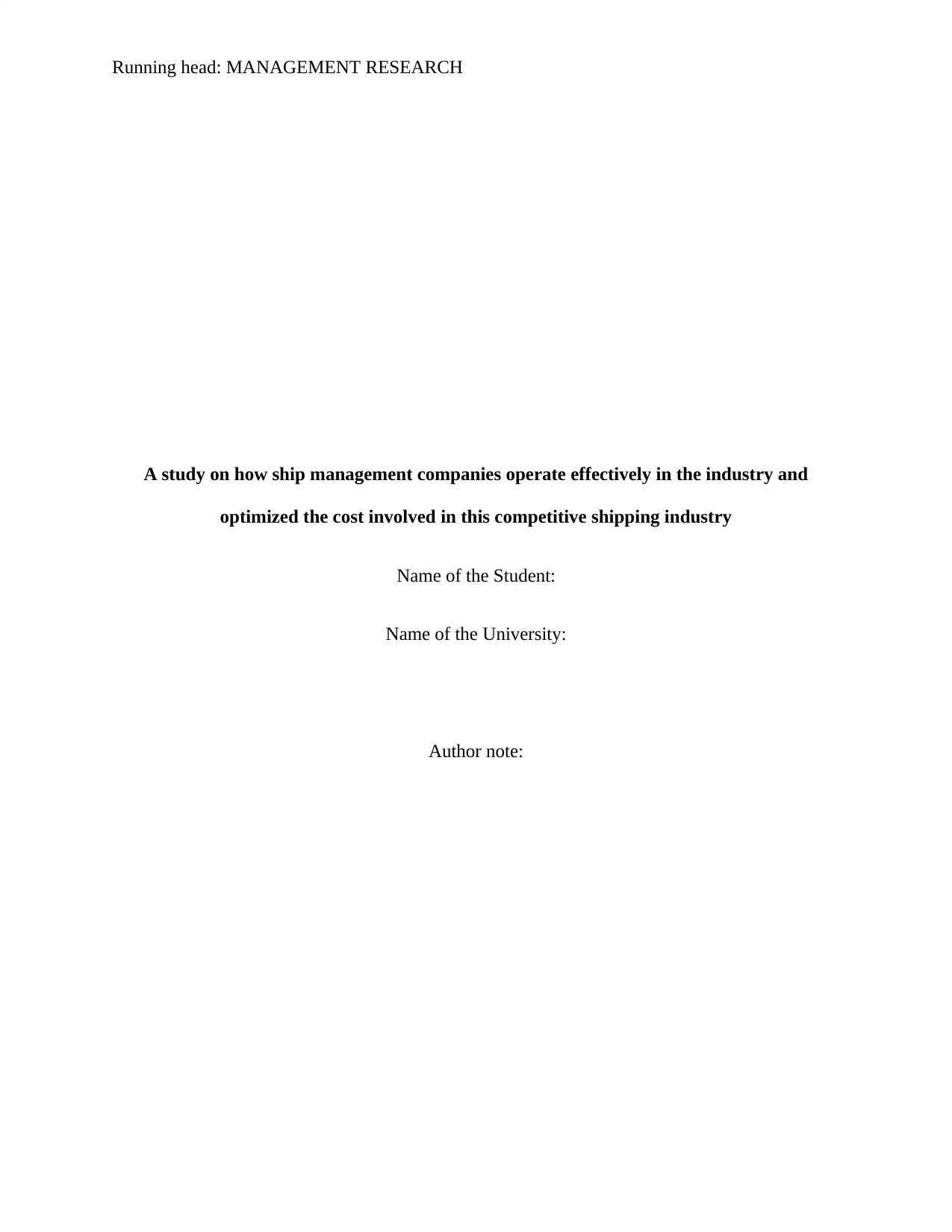
Running head: MANAGEMENT RESEARCH
A study on how ship management companies operate effectively in the industry and
optimized the cost involved in this competitive shipping industry
Name of the Student:
Name of the University:
Author note:
A study on how ship management companies operate effectively in the industry and
optimized the cost involved in this competitive shipping industry
Name of the Student:
Name of the University:
Author note:
Paraphrase This Document
Need a fresh take? Get an instant paraphrase of this document with our AI Paraphraser
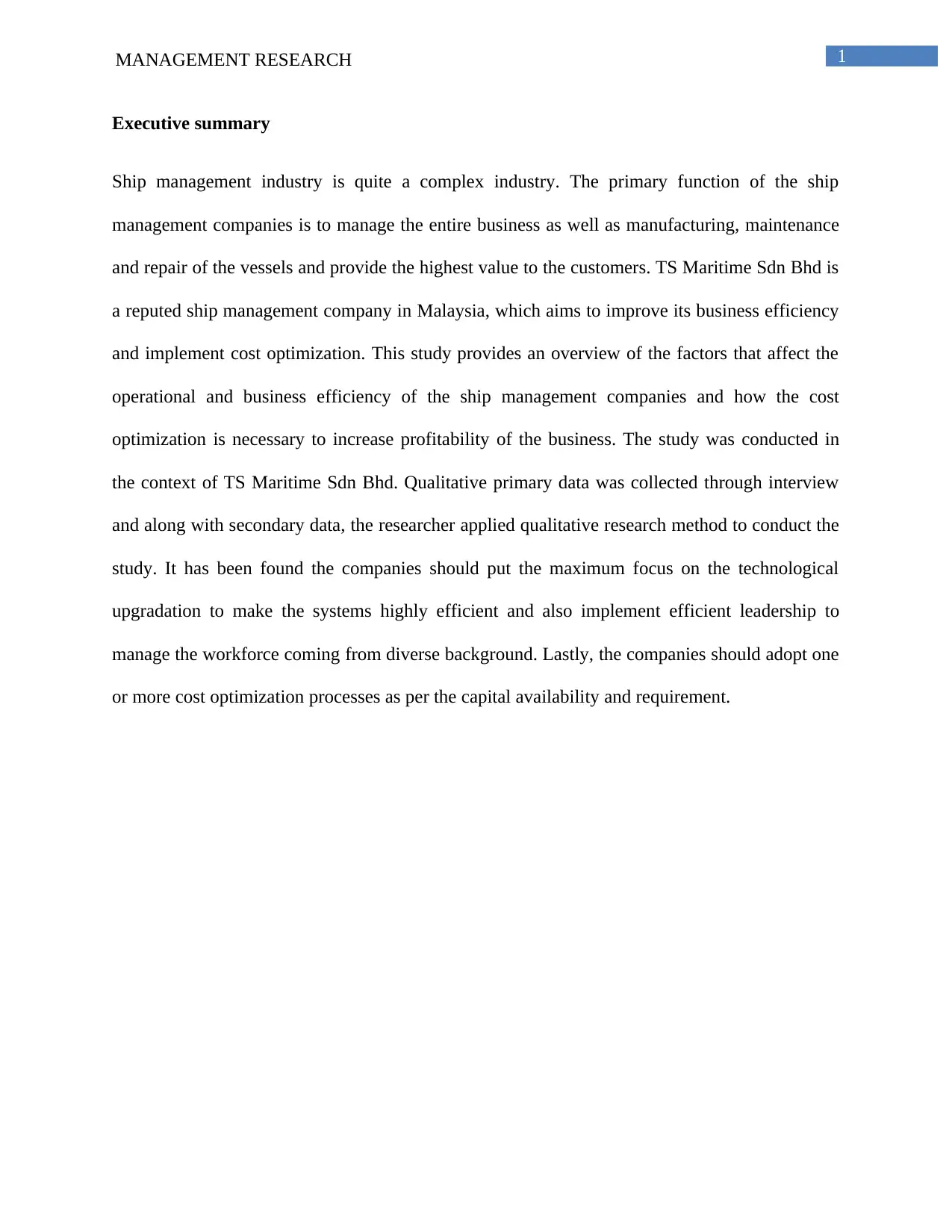
1MANAGEMENT RESEARCH
Executive summary
Ship management industry is quite a complex industry. The primary function of the ship
management companies is to manage the entire business as well as manufacturing, maintenance
and repair of the vessels and provide the highest value to the customers. TS Maritime Sdn Bhd is
a reputed ship management company in Malaysia, which aims to improve its business efficiency
and implement cost optimization. This study provides an overview of the factors that affect the
operational and business efficiency of the ship management companies and how the cost
optimization is necessary to increase profitability of the business. The study was conducted in
the context of TS Maritime Sdn Bhd. Qualitative primary data was collected through interview
and along with secondary data, the researcher applied qualitative research method to conduct the
study. It has been found the companies should put the maximum focus on the technological
upgradation to make the systems highly efficient and also implement efficient leadership to
manage the workforce coming from diverse background. Lastly, the companies should adopt one
or more cost optimization processes as per the capital availability and requirement.
Executive summary
Ship management industry is quite a complex industry. The primary function of the ship
management companies is to manage the entire business as well as manufacturing, maintenance
and repair of the vessels and provide the highest value to the customers. TS Maritime Sdn Bhd is
a reputed ship management company in Malaysia, which aims to improve its business efficiency
and implement cost optimization. This study provides an overview of the factors that affect the
operational and business efficiency of the ship management companies and how the cost
optimization is necessary to increase profitability of the business. The study was conducted in
the context of TS Maritime Sdn Bhd. Qualitative primary data was collected through interview
and along with secondary data, the researcher applied qualitative research method to conduct the
study. It has been found the companies should put the maximum focus on the technological
upgradation to make the systems highly efficient and also implement efficient leadership to
manage the workforce coming from diverse background. Lastly, the companies should adopt one
or more cost optimization processes as per the capital availability and requirement.
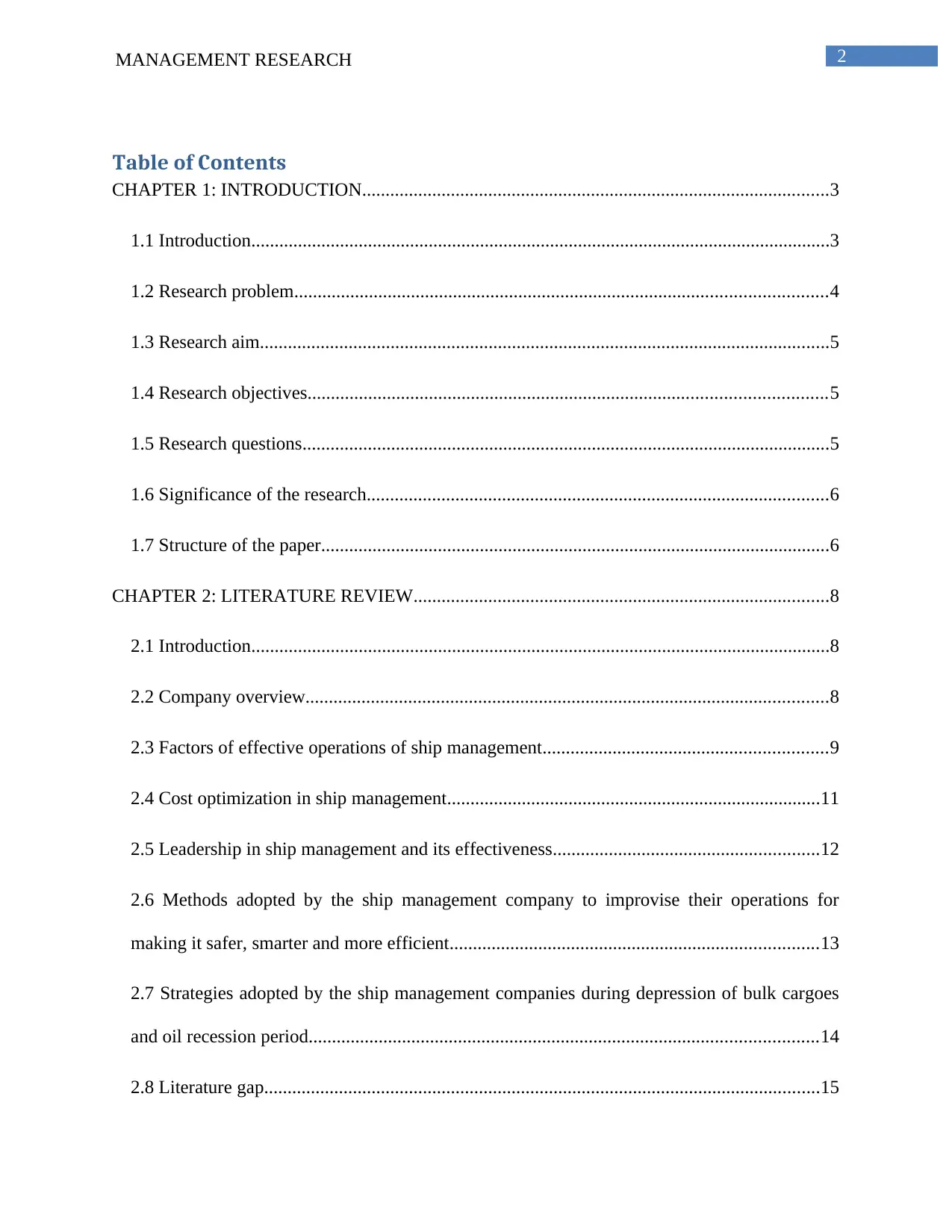
2MANAGEMENT RESEARCH
Table of Contents
CHAPTER 1: INTRODUCTION....................................................................................................3
1.1 Introduction............................................................................................................................3
1.2 Research problem..................................................................................................................4
1.3 Research aim..........................................................................................................................5
1.4 Research objectives...............................................................................................................5
1.5 Research questions.................................................................................................................5
1.6 Significance of the research...................................................................................................6
1.7 Structure of the paper.............................................................................................................6
CHAPTER 2: LITERATURE REVIEW.........................................................................................8
2.1 Introduction............................................................................................................................8
2.2 Company overview................................................................................................................8
2.3 Factors of effective operations of ship management.............................................................9
2.4 Cost optimization in ship management................................................................................11
2.5 Leadership in ship management and its effectiveness.........................................................12
2.6 Methods adopted by the ship management company to improvise their operations for
making it safer, smarter and more efficient...............................................................................13
2.7 Strategies adopted by the ship management companies during depression of bulk cargoes
and oil recession period.............................................................................................................14
2.8 Literature gap.......................................................................................................................15
Table of Contents
CHAPTER 1: INTRODUCTION....................................................................................................3
1.1 Introduction............................................................................................................................3
1.2 Research problem..................................................................................................................4
1.3 Research aim..........................................................................................................................5
1.4 Research objectives...............................................................................................................5
1.5 Research questions.................................................................................................................5
1.6 Significance of the research...................................................................................................6
1.7 Structure of the paper.............................................................................................................6
CHAPTER 2: LITERATURE REVIEW.........................................................................................8
2.1 Introduction............................................................................................................................8
2.2 Company overview................................................................................................................8
2.3 Factors of effective operations of ship management.............................................................9
2.4 Cost optimization in ship management................................................................................11
2.5 Leadership in ship management and its effectiveness.........................................................12
2.6 Methods adopted by the ship management company to improvise their operations for
making it safer, smarter and more efficient...............................................................................13
2.7 Strategies adopted by the ship management companies during depression of bulk cargoes
and oil recession period.............................................................................................................14
2.8 Literature gap.......................................................................................................................15
⊘ This is a preview!⊘
Do you want full access?
Subscribe today to unlock all pages.

Trusted by 1+ million students worldwide
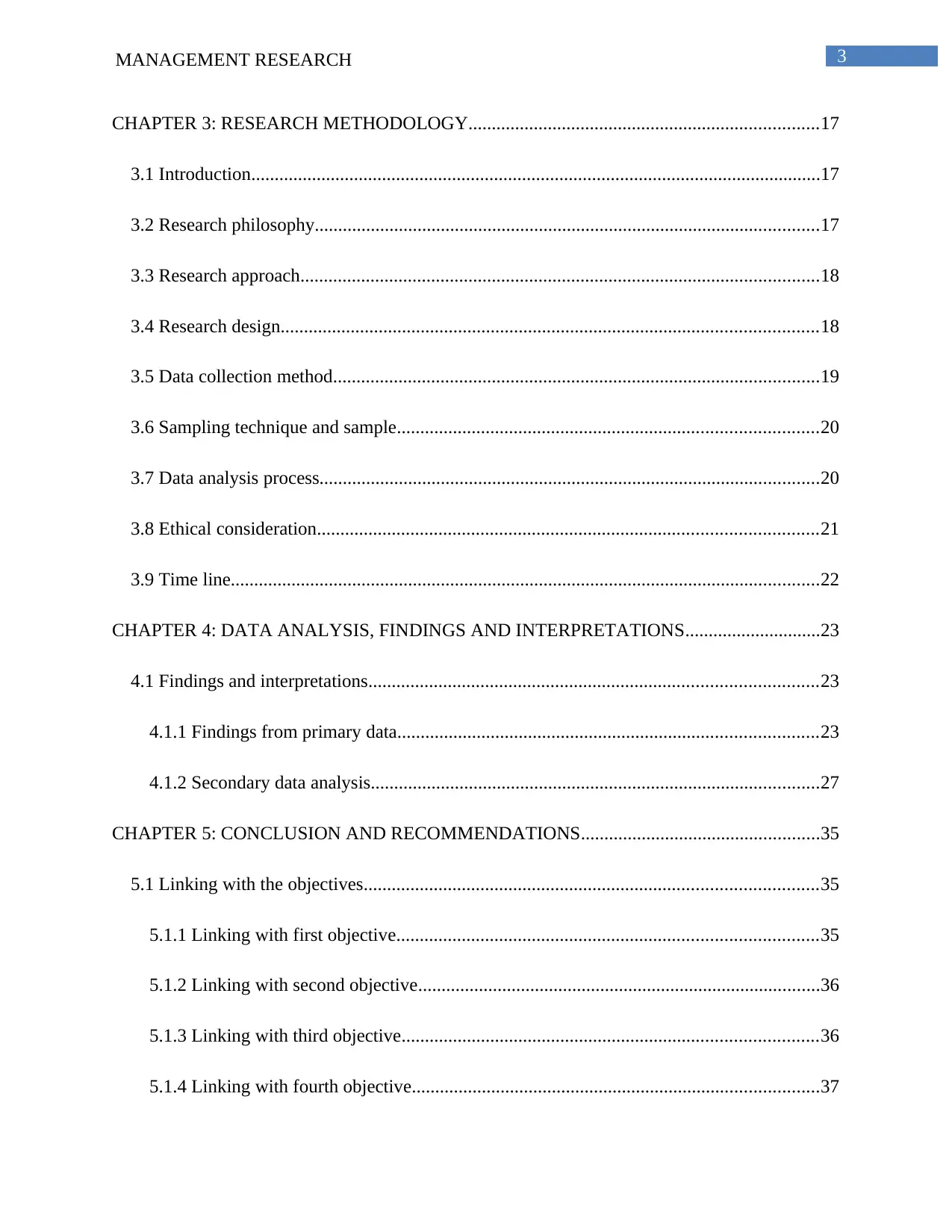
3MANAGEMENT RESEARCH
CHAPTER 3: RESEARCH METHODOLOGY...........................................................................17
3.1 Introduction..........................................................................................................................17
3.2 Research philosophy............................................................................................................17
3.3 Research approach...............................................................................................................18
3.4 Research design...................................................................................................................18
3.5 Data collection method........................................................................................................19
3.6 Sampling technique and sample..........................................................................................20
3.7 Data analysis process...........................................................................................................20
3.8 Ethical consideration...........................................................................................................21
3.9 Time line..............................................................................................................................22
CHAPTER 4: DATA ANALYSIS, FINDINGS AND INTERPRETATIONS.............................23
4.1 Findings and interpretations................................................................................................23
4.1.1 Findings from primary data..........................................................................................23
4.1.2 Secondary data analysis................................................................................................27
CHAPTER 5: CONCLUSION AND RECOMMENDATIONS...................................................35
5.1 Linking with the objectives.................................................................................................35
5.1.1 Linking with first objective..........................................................................................35
5.1.2 Linking with second objective......................................................................................36
5.1.3 Linking with third objective.........................................................................................36
5.1.4 Linking with fourth objective.......................................................................................37
CHAPTER 3: RESEARCH METHODOLOGY...........................................................................17
3.1 Introduction..........................................................................................................................17
3.2 Research philosophy............................................................................................................17
3.3 Research approach...............................................................................................................18
3.4 Research design...................................................................................................................18
3.5 Data collection method........................................................................................................19
3.6 Sampling technique and sample..........................................................................................20
3.7 Data analysis process...........................................................................................................20
3.8 Ethical consideration...........................................................................................................21
3.9 Time line..............................................................................................................................22
CHAPTER 4: DATA ANALYSIS, FINDINGS AND INTERPRETATIONS.............................23
4.1 Findings and interpretations................................................................................................23
4.1.1 Findings from primary data..........................................................................................23
4.1.2 Secondary data analysis................................................................................................27
CHAPTER 5: CONCLUSION AND RECOMMENDATIONS...................................................35
5.1 Linking with the objectives.................................................................................................35
5.1.1 Linking with first objective..........................................................................................35
5.1.2 Linking with second objective......................................................................................36
5.1.3 Linking with third objective.........................................................................................36
5.1.4 Linking with fourth objective.......................................................................................37
Paraphrase This Document
Need a fresh take? Get an instant paraphrase of this document with our AI Paraphraser
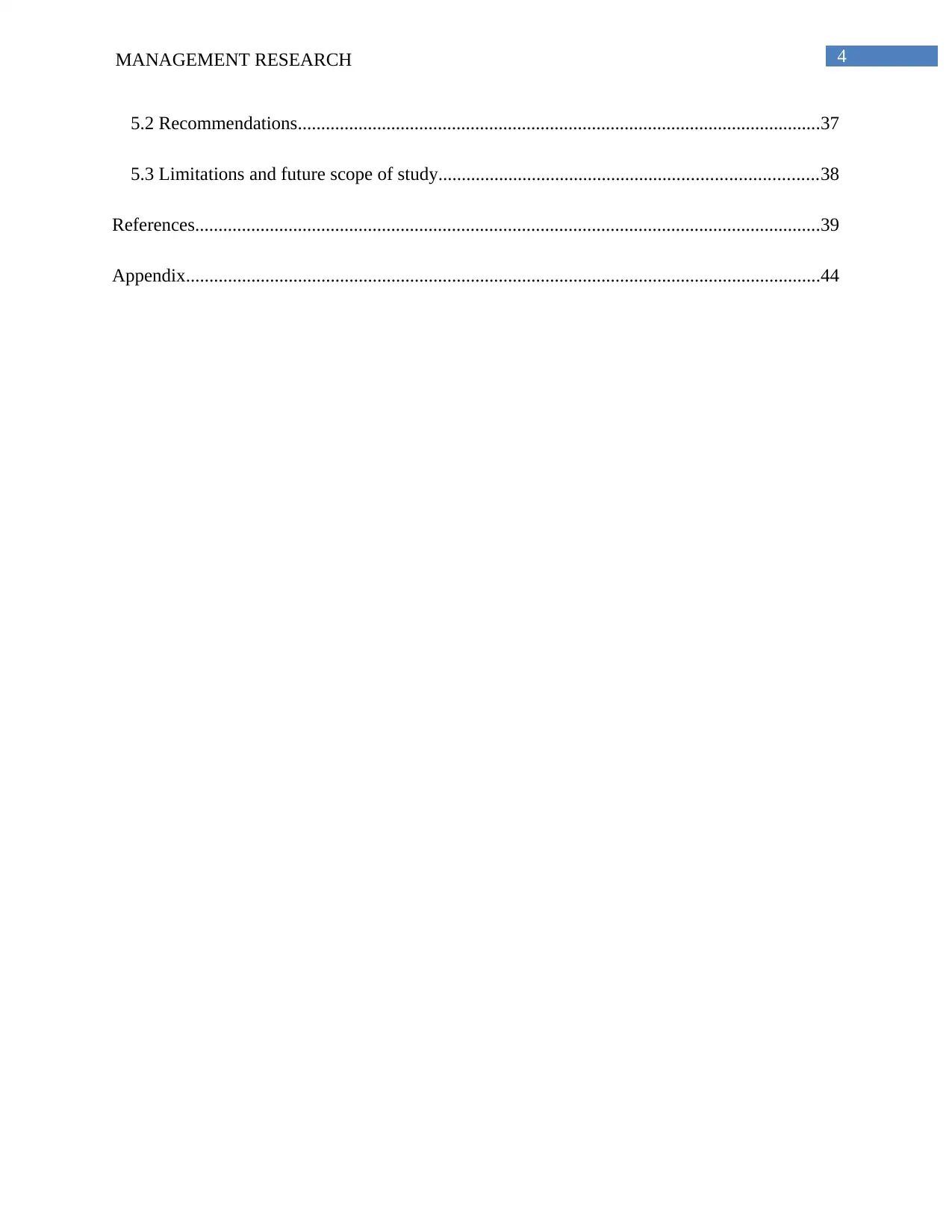
4MANAGEMENT RESEARCH
5.2 Recommendations................................................................................................................37
5.3 Limitations and future scope of study.................................................................................38
References......................................................................................................................................39
Appendix........................................................................................................................................44
5.2 Recommendations................................................................................................................37
5.3 Limitations and future scope of study.................................................................................38
References......................................................................................................................................39
Appendix........................................................................................................................................44
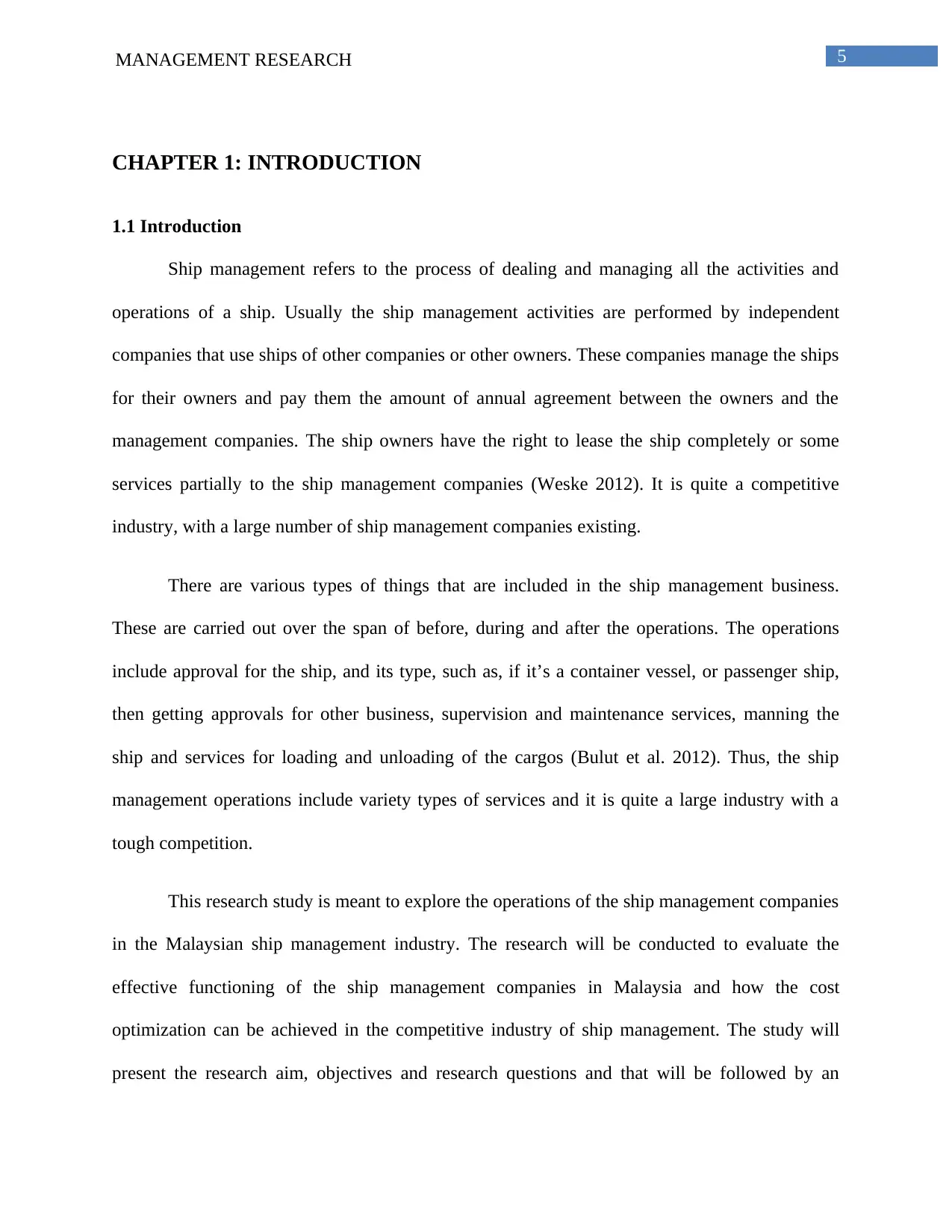
5MANAGEMENT RESEARCH
CHAPTER 1: INTRODUCTION
1.1 Introduction
Ship management refers to the process of dealing and managing all the activities and
operations of a ship. Usually the ship management activities are performed by independent
companies that use ships of other companies or other owners. These companies manage the ships
for their owners and pay them the amount of annual agreement between the owners and the
management companies. The ship owners have the right to lease the ship completely or some
services partially to the ship management companies (Weske 2012). It is quite a competitive
industry, with a large number of ship management companies existing.
There are various types of things that are included in the ship management business.
These are carried out over the span of before, during and after the operations. The operations
include approval for the ship, and its type, such as, if it’s a container vessel, or passenger ship,
then getting approvals for other business, supervision and maintenance services, manning the
ship and services for loading and unloading of the cargos (Bulut et al. 2012). Thus, the ship
management operations include variety types of services and it is quite a large industry with a
tough competition.
This research study is meant to explore the operations of the ship management companies
in the Malaysian ship management industry. The research will be conducted to evaluate the
effective functioning of the ship management companies in Malaysia and how the cost
optimization can be achieved in the competitive industry of ship management. The study will
present the research aim, objectives and research questions and that will be followed by an
CHAPTER 1: INTRODUCTION
1.1 Introduction
Ship management refers to the process of dealing and managing all the activities and
operations of a ship. Usually the ship management activities are performed by independent
companies that use ships of other companies or other owners. These companies manage the ships
for their owners and pay them the amount of annual agreement between the owners and the
management companies. The ship owners have the right to lease the ship completely or some
services partially to the ship management companies (Weske 2012). It is quite a competitive
industry, with a large number of ship management companies existing.
There are various types of things that are included in the ship management business.
These are carried out over the span of before, during and after the operations. The operations
include approval for the ship, and its type, such as, if it’s a container vessel, or passenger ship,
then getting approvals for other business, supervision and maintenance services, manning the
ship and services for loading and unloading of the cargos (Bulut et al. 2012). Thus, the ship
management operations include variety types of services and it is quite a large industry with a
tough competition.
This research study is meant to explore the operations of the ship management companies
in the Malaysian ship management industry. The research will be conducted to evaluate the
effective functioning of the ship management companies in Malaysia and how the cost
optimization can be achieved in the competitive industry of ship management. The study will
present the research aim, objectives and research questions and that will be followed by an
⊘ This is a preview!⊘
Do you want full access?
Subscribe today to unlock all pages.

Trusted by 1+ million students worldwide
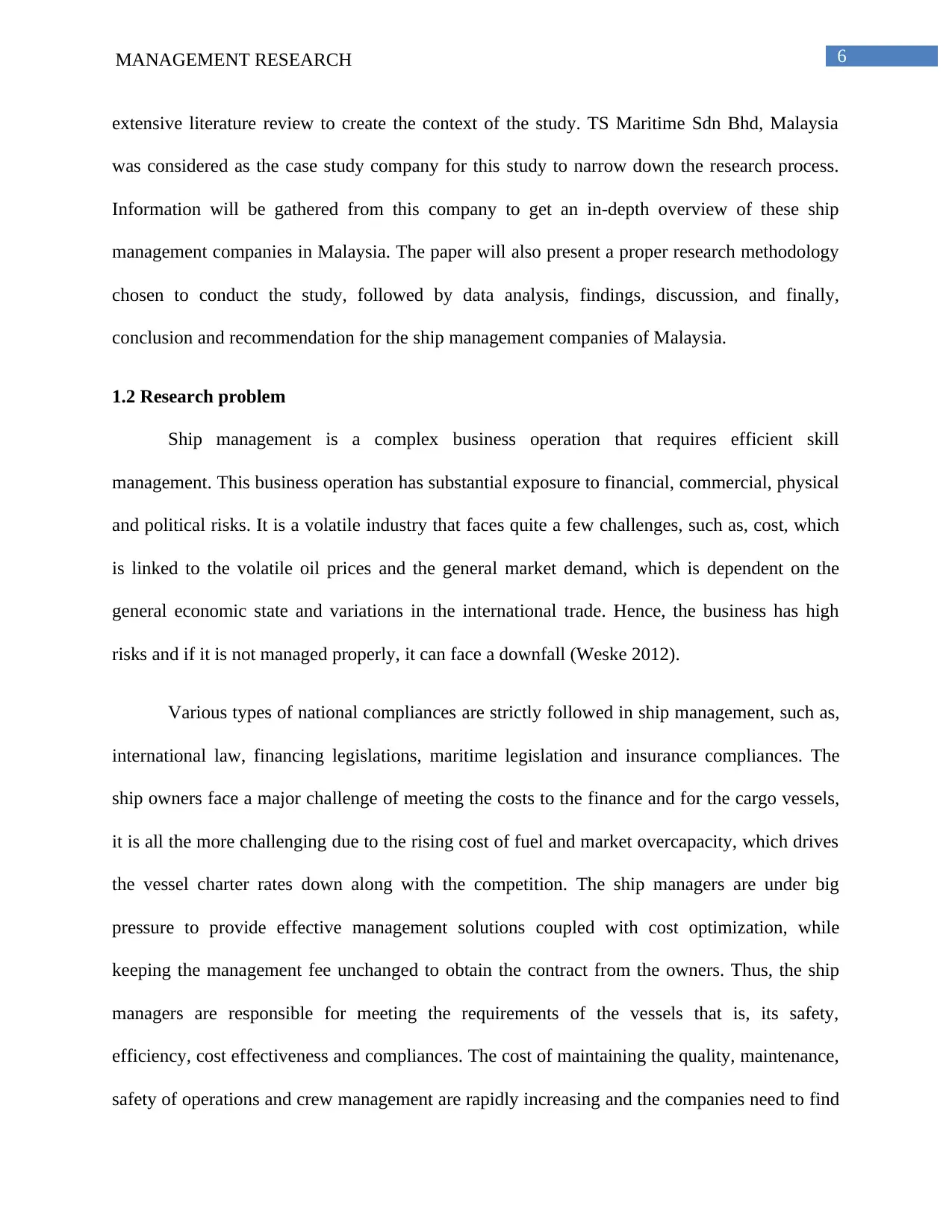
6MANAGEMENT RESEARCH
extensive literature review to create the context of the study. TS Maritime Sdn Bhd, Malaysia
was considered as the case study company for this study to narrow down the research process.
Information will be gathered from this company to get an in-depth overview of these ship
management companies in Malaysia. The paper will also present a proper research methodology
chosen to conduct the study, followed by data analysis, findings, discussion, and finally,
conclusion and recommendation for the ship management companies of Malaysia.
1.2 Research problem
Ship management is a complex business operation that requires efficient skill
management. This business operation has substantial exposure to financial, commercial, physical
and political risks. It is a volatile industry that faces quite a few challenges, such as, cost, which
is linked to the volatile oil prices and the general market demand, which is dependent on the
general economic state and variations in the international trade. Hence, the business has high
risks and if it is not managed properly, it can face a downfall (Weske 2012).
Various types of national compliances are strictly followed in ship management, such as,
international law, financing legislations, maritime legislation and insurance compliances. The
ship owners face a major challenge of meeting the costs to the finance and for the cargo vessels,
it is all the more challenging due to the rising cost of fuel and market overcapacity, which drives
the vessel charter rates down along with the competition. The ship managers are under big
pressure to provide effective management solutions coupled with cost optimization, while
keeping the management fee unchanged to obtain the contract from the owners. Thus, the ship
managers are responsible for meeting the requirements of the vessels that is, its safety,
efficiency, cost effectiveness and compliances. The cost of maintaining the quality, maintenance,
safety of operations and crew management are rapidly increasing and the companies need to find
extensive literature review to create the context of the study. TS Maritime Sdn Bhd, Malaysia
was considered as the case study company for this study to narrow down the research process.
Information will be gathered from this company to get an in-depth overview of these ship
management companies in Malaysia. The paper will also present a proper research methodology
chosen to conduct the study, followed by data analysis, findings, discussion, and finally,
conclusion and recommendation for the ship management companies of Malaysia.
1.2 Research problem
Ship management is a complex business operation that requires efficient skill
management. This business operation has substantial exposure to financial, commercial, physical
and political risks. It is a volatile industry that faces quite a few challenges, such as, cost, which
is linked to the volatile oil prices and the general market demand, which is dependent on the
general economic state and variations in the international trade. Hence, the business has high
risks and if it is not managed properly, it can face a downfall (Weske 2012).
Various types of national compliances are strictly followed in ship management, such as,
international law, financing legislations, maritime legislation and insurance compliances. The
ship owners face a major challenge of meeting the costs to the finance and for the cargo vessels,
it is all the more challenging due to the rising cost of fuel and market overcapacity, which drives
the vessel charter rates down along with the competition. The ship managers are under big
pressure to provide effective management solutions coupled with cost optimization, while
keeping the management fee unchanged to obtain the contract from the owners. Thus, the ship
managers are responsible for meeting the requirements of the vessels that is, its safety,
efficiency, cost effectiveness and compliances. The cost of maintaining the quality, maintenance,
safety of operations and crew management are rapidly increasing and the companies need to find
Paraphrase This Document
Need a fresh take? Get an instant paraphrase of this document with our AI Paraphraser
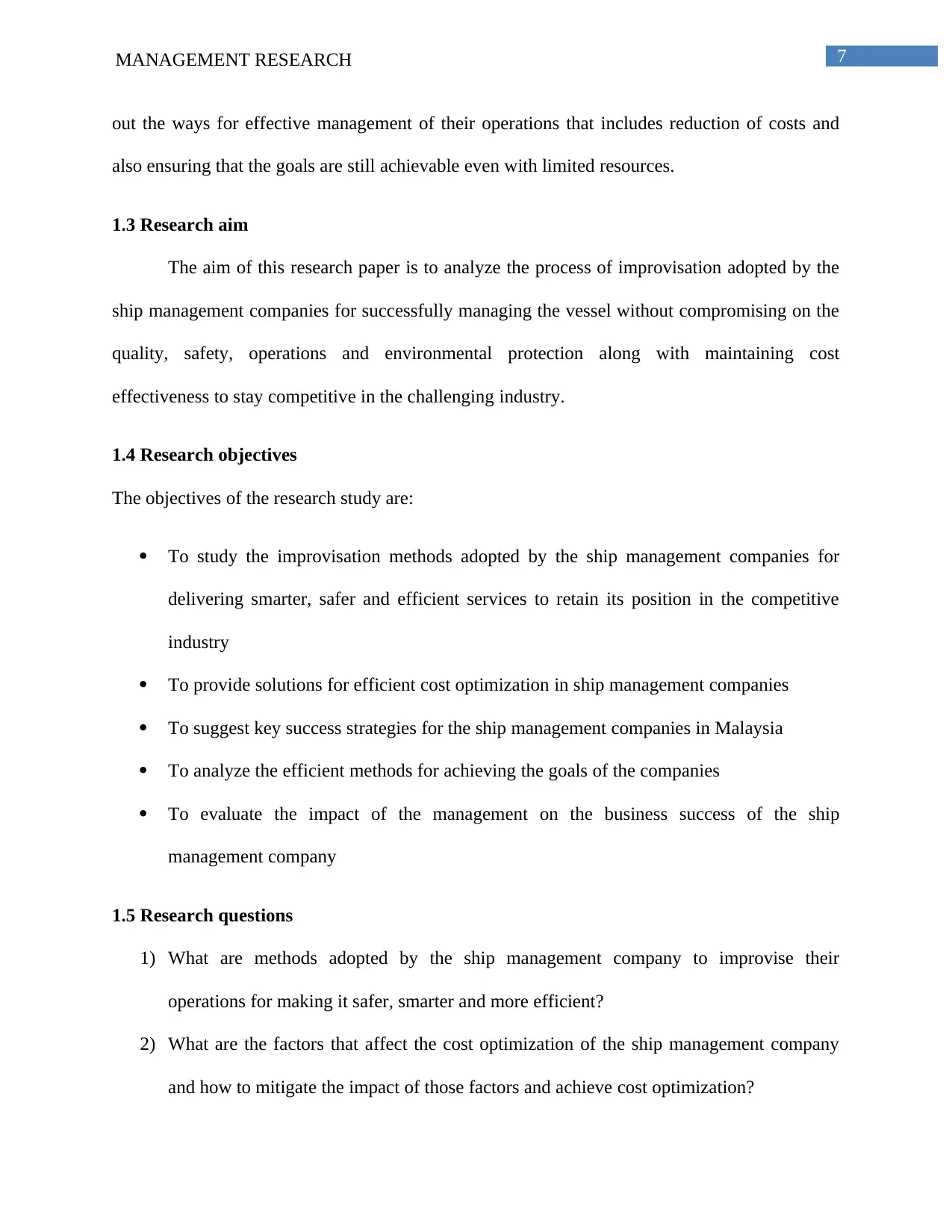
7MANAGEMENT RESEARCH
out the ways for effective management of their operations that includes reduction of costs and
also ensuring that the goals are still achievable even with limited resources.
1.3 Research aim
The aim of this research paper is to analyze the process of improvisation adopted by the
ship management companies for successfully managing the vessel without compromising on the
quality, safety, operations and environmental protection along with maintaining cost
effectiveness to stay competitive in the challenging industry.
1.4 Research objectives
The objectives of the research study are:
To study the improvisation methods adopted by the ship management companies for
delivering smarter, safer and efficient services to retain its position in the competitive
industry
To provide solutions for efficient cost optimization in ship management companies
To suggest key success strategies for the ship management companies in Malaysia
To analyze the efficient methods for achieving the goals of the companies
To evaluate the impact of the management on the business success of the ship
management company
1.5 Research questions
1) What are methods adopted by the ship management company to improvise their
operations for making it safer, smarter and more efficient?
2) What are the factors that affect the cost optimization of the ship management company
and how to mitigate the impact of those factors and achieve cost optimization?
out the ways for effective management of their operations that includes reduction of costs and
also ensuring that the goals are still achievable even with limited resources.
1.3 Research aim
The aim of this research paper is to analyze the process of improvisation adopted by the
ship management companies for successfully managing the vessel without compromising on the
quality, safety, operations and environmental protection along with maintaining cost
effectiveness to stay competitive in the challenging industry.
1.4 Research objectives
The objectives of the research study are:
To study the improvisation methods adopted by the ship management companies for
delivering smarter, safer and efficient services to retain its position in the competitive
industry
To provide solutions for efficient cost optimization in ship management companies
To suggest key success strategies for the ship management companies in Malaysia
To analyze the efficient methods for achieving the goals of the companies
To evaluate the impact of the management on the business success of the ship
management company
1.5 Research questions
1) What are methods adopted by the ship management company to improvise their
operations for making it safer, smarter and more efficient?
2) What are the factors that affect the cost optimization of the ship management company
and how to mitigate the impact of those factors and achieve cost optimization?
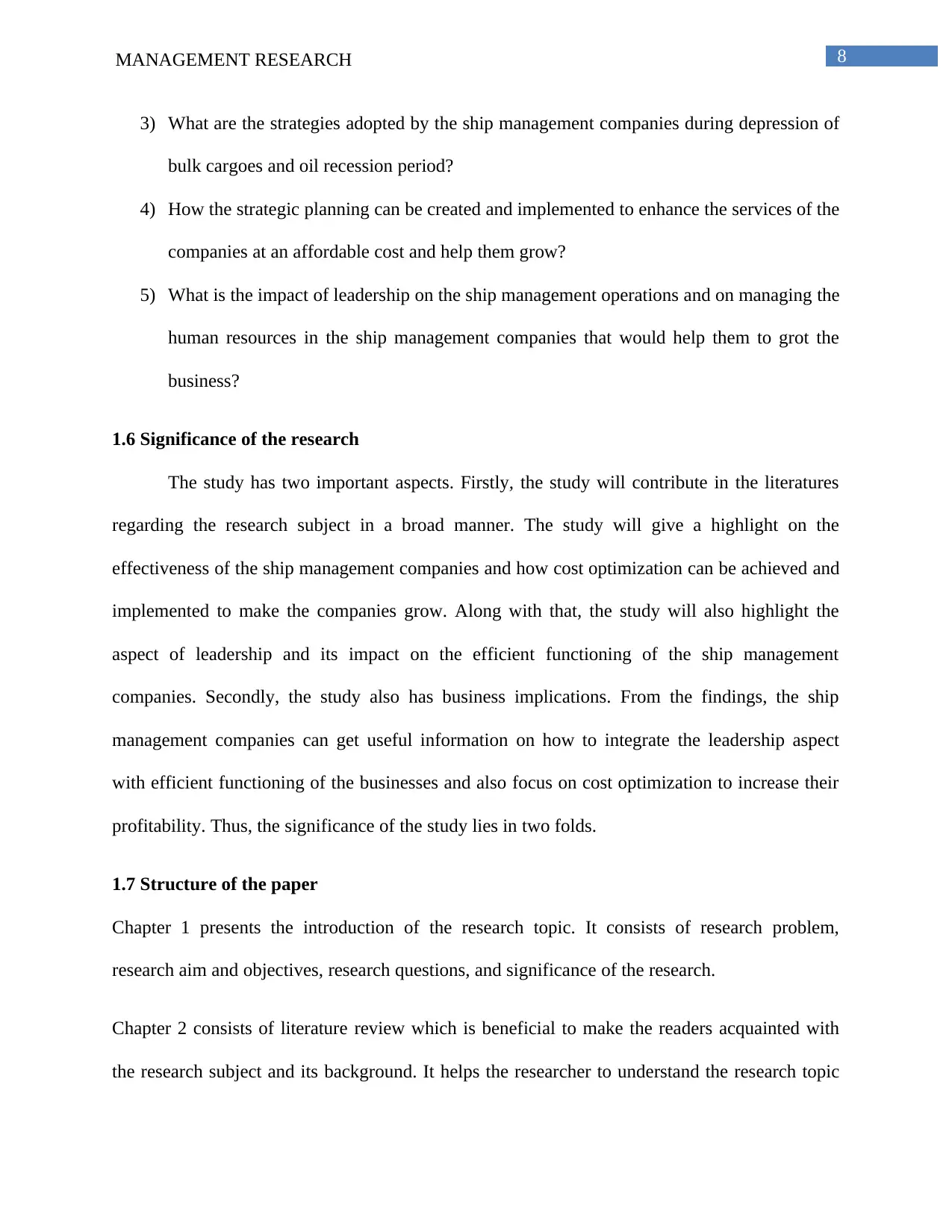
8MANAGEMENT RESEARCH
3) What are the strategies adopted by the ship management companies during depression of
bulk cargoes and oil recession period?
4) How the strategic planning can be created and implemented to enhance the services of the
companies at an affordable cost and help them grow?
5) What is the impact of leadership on the ship management operations and on managing the
human resources in the ship management companies that would help them to grot the
business?
1.6 Significance of the research
The study has two important aspects. Firstly, the study will contribute in the literatures
regarding the research subject in a broad manner. The study will give a highlight on the
effectiveness of the ship management companies and how cost optimization can be achieved and
implemented to make the companies grow. Along with that, the study will also highlight the
aspect of leadership and its impact on the efficient functioning of the ship management
companies. Secondly, the study also has business implications. From the findings, the ship
management companies can get useful information on how to integrate the leadership aspect
with efficient functioning of the businesses and also focus on cost optimization to increase their
profitability. Thus, the significance of the study lies in two folds.
1.7 Structure of the paper
Chapter 1 presents the introduction of the research topic. It consists of research problem,
research aim and objectives, research questions, and significance of the research.
Chapter 2 consists of literature review which is beneficial to make the readers acquainted with
the research subject and its background. It helps the researcher to understand the research topic
3) What are the strategies adopted by the ship management companies during depression of
bulk cargoes and oil recession period?
4) How the strategic planning can be created and implemented to enhance the services of the
companies at an affordable cost and help them grow?
5) What is the impact of leadership on the ship management operations and on managing the
human resources in the ship management companies that would help them to grot the
business?
1.6 Significance of the research
The study has two important aspects. Firstly, the study will contribute in the literatures
regarding the research subject in a broad manner. The study will give a highlight on the
effectiveness of the ship management companies and how cost optimization can be achieved and
implemented to make the companies grow. Along with that, the study will also highlight the
aspect of leadership and its impact on the efficient functioning of the ship management
companies. Secondly, the study also has business implications. From the findings, the ship
management companies can get useful information on how to integrate the leadership aspect
with efficient functioning of the businesses and also focus on cost optimization to increase their
profitability. Thus, the significance of the study lies in two folds.
1.7 Structure of the paper
Chapter 1 presents the introduction of the research topic. It consists of research problem,
research aim and objectives, research questions, and significance of the research.
Chapter 2 consists of literature review which is beneficial to make the readers acquainted with
the research subject and its background. It helps the researcher to understand the research topic
⊘ This is a preview!⊘
Do you want full access?
Subscribe today to unlock all pages.

Trusted by 1+ million students worldwide
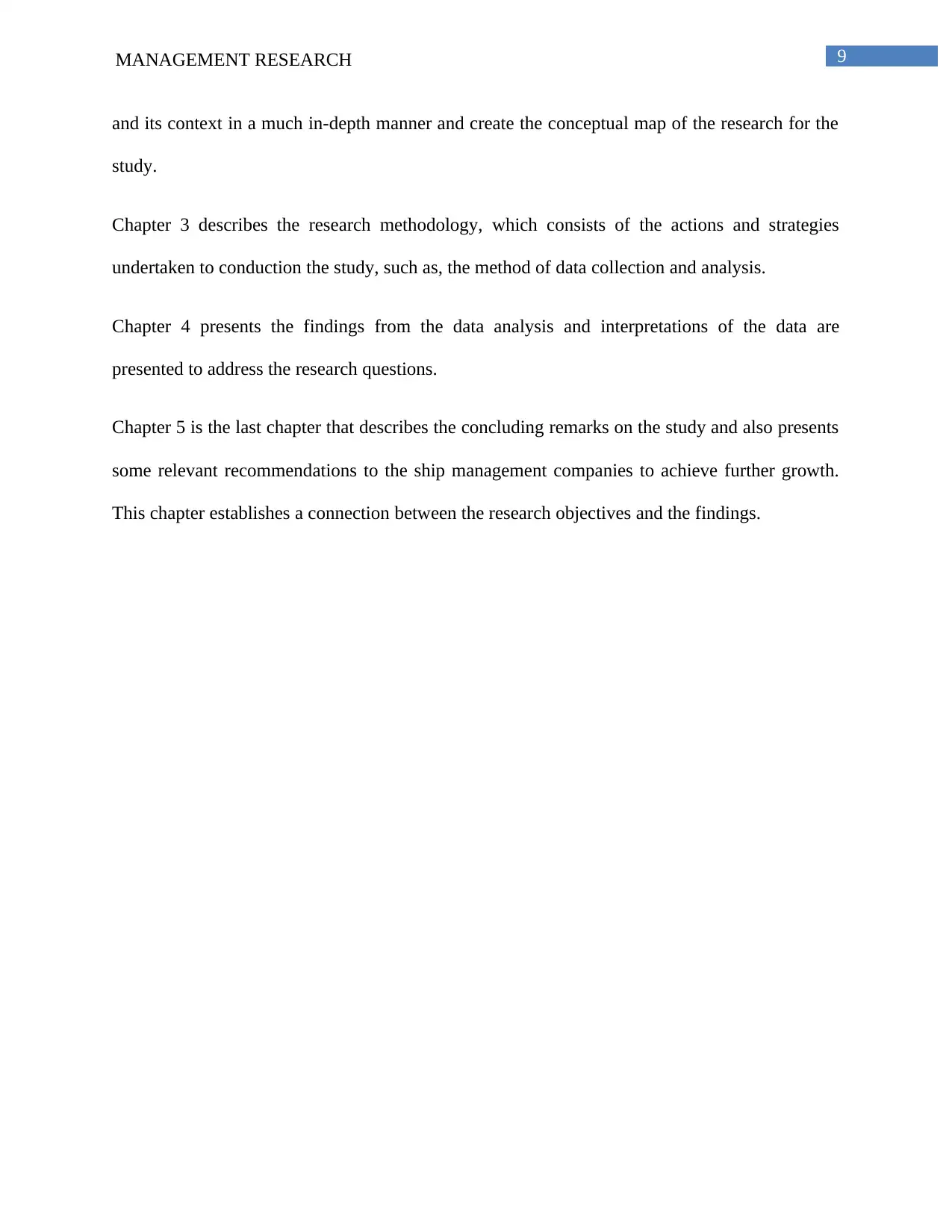
9MANAGEMENT RESEARCH
and its context in a much in-depth manner and create the conceptual map of the research for the
study.
Chapter 3 describes the research methodology, which consists of the actions and strategies
undertaken to conduction the study, such as, the method of data collection and analysis.
Chapter 4 presents the findings from the data analysis and interpretations of the data are
presented to address the research questions.
Chapter 5 is the last chapter that describes the concluding remarks on the study and also presents
some relevant recommendations to the ship management companies to achieve further growth.
This chapter establishes a connection between the research objectives and the findings.
and its context in a much in-depth manner and create the conceptual map of the research for the
study.
Chapter 3 describes the research methodology, which consists of the actions and strategies
undertaken to conduction the study, such as, the method of data collection and analysis.
Chapter 4 presents the findings from the data analysis and interpretations of the data are
presented to address the research questions.
Chapter 5 is the last chapter that describes the concluding remarks on the study and also presents
some relevant recommendations to the ship management companies to achieve further growth.
This chapter establishes a connection between the research objectives and the findings.
Paraphrase This Document
Need a fresh take? Get an instant paraphrase of this document with our AI Paraphraser
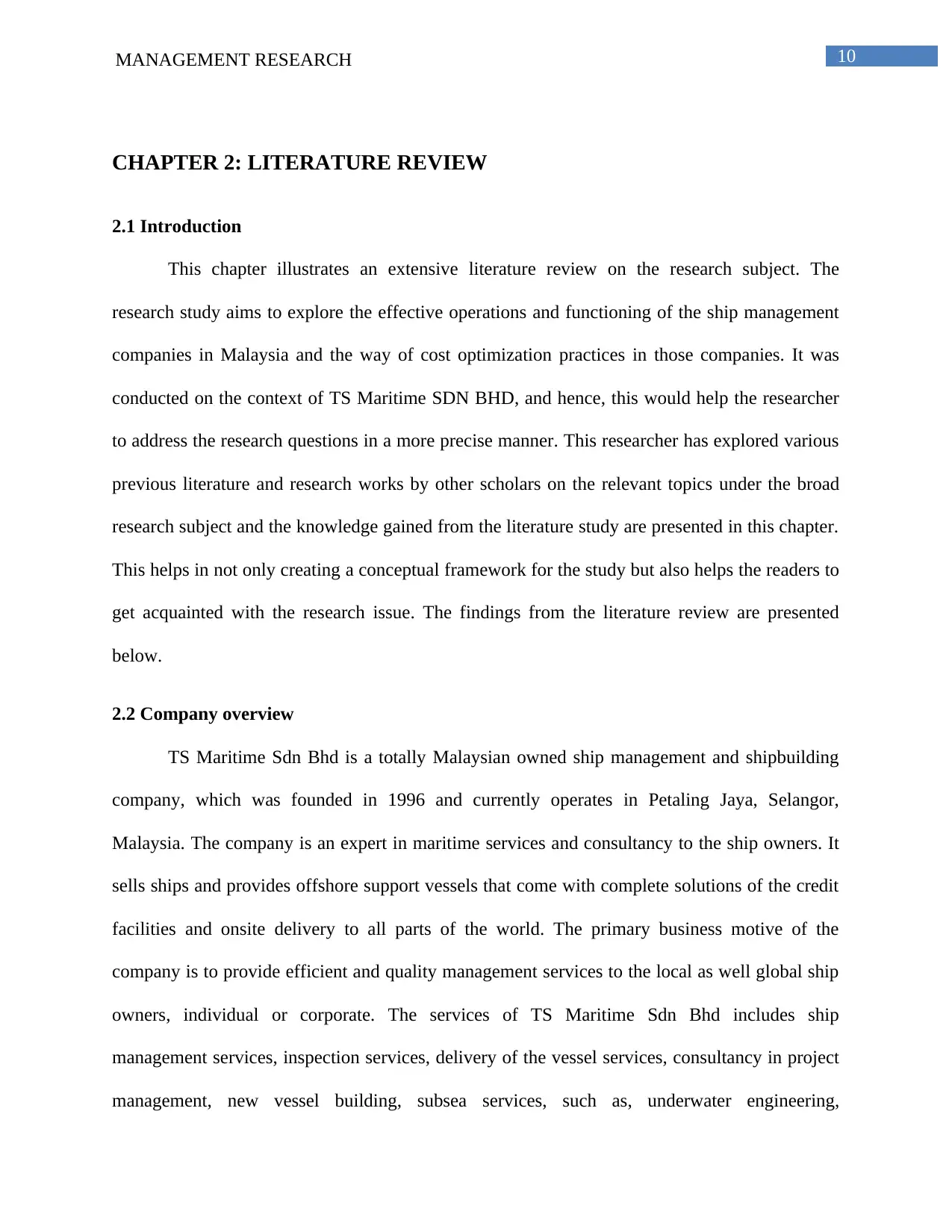
10MANAGEMENT RESEARCH
CHAPTER 2: LITERATURE REVIEW
2.1 Introduction
This chapter illustrates an extensive literature review on the research subject. The
research study aims to explore the effective operations and functioning of the ship management
companies in Malaysia and the way of cost optimization practices in those companies. It was
conducted on the context of TS Maritime SDN BHD, and hence, this would help the researcher
to address the research questions in a more precise manner. This researcher has explored various
previous literature and research works by other scholars on the relevant topics under the broad
research subject and the knowledge gained from the literature study are presented in this chapter.
This helps in not only creating a conceptual framework for the study but also helps the readers to
get acquainted with the research issue. The findings from the literature review are presented
below.
2.2 Company overview
TS Maritime Sdn Bhd is a totally Malaysian owned ship management and shipbuilding
company, which was founded in 1996 and currently operates in Petaling Jaya, Selangor,
Malaysia. The company is an expert in maritime services and consultancy to the ship owners. It
sells ships and provides offshore support vessels that come with complete solutions of the credit
facilities and onsite delivery to all parts of the world. The primary business motive of the
company is to provide efficient and quality management services to the local as well global ship
owners, individual or corporate. The services of TS Maritime Sdn Bhd includes ship
management services, inspection services, delivery of the vessel services, consultancy in project
management, new vessel building, subsea services, such as, underwater engineering,
CHAPTER 2: LITERATURE REVIEW
2.1 Introduction
This chapter illustrates an extensive literature review on the research subject. The
research study aims to explore the effective operations and functioning of the ship management
companies in Malaysia and the way of cost optimization practices in those companies. It was
conducted on the context of TS Maritime SDN BHD, and hence, this would help the researcher
to address the research questions in a more precise manner. This researcher has explored various
previous literature and research works by other scholars on the relevant topics under the broad
research subject and the knowledge gained from the literature study are presented in this chapter.
This helps in not only creating a conceptual framework for the study but also helps the readers to
get acquainted with the research issue. The findings from the literature review are presented
below.
2.2 Company overview
TS Maritime Sdn Bhd is a totally Malaysian owned ship management and shipbuilding
company, which was founded in 1996 and currently operates in Petaling Jaya, Selangor,
Malaysia. The company is an expert in maritime services and consultancy to the ship owners. It
sells ships and provides offshore support vessels that come with complete solutions of the credit
facilities and onsite delivery to all parts of the world. The primary business motive of the
company is to provide efficient and quality management services to the local as well global ship
owners, individual or corporate. The services of TS Maritime Sdn Bhd includes ship
management services, inspection services, delivery of the vessel services, consultancy in project
management, new vessel building, subsea services, such as, underwater engineering,
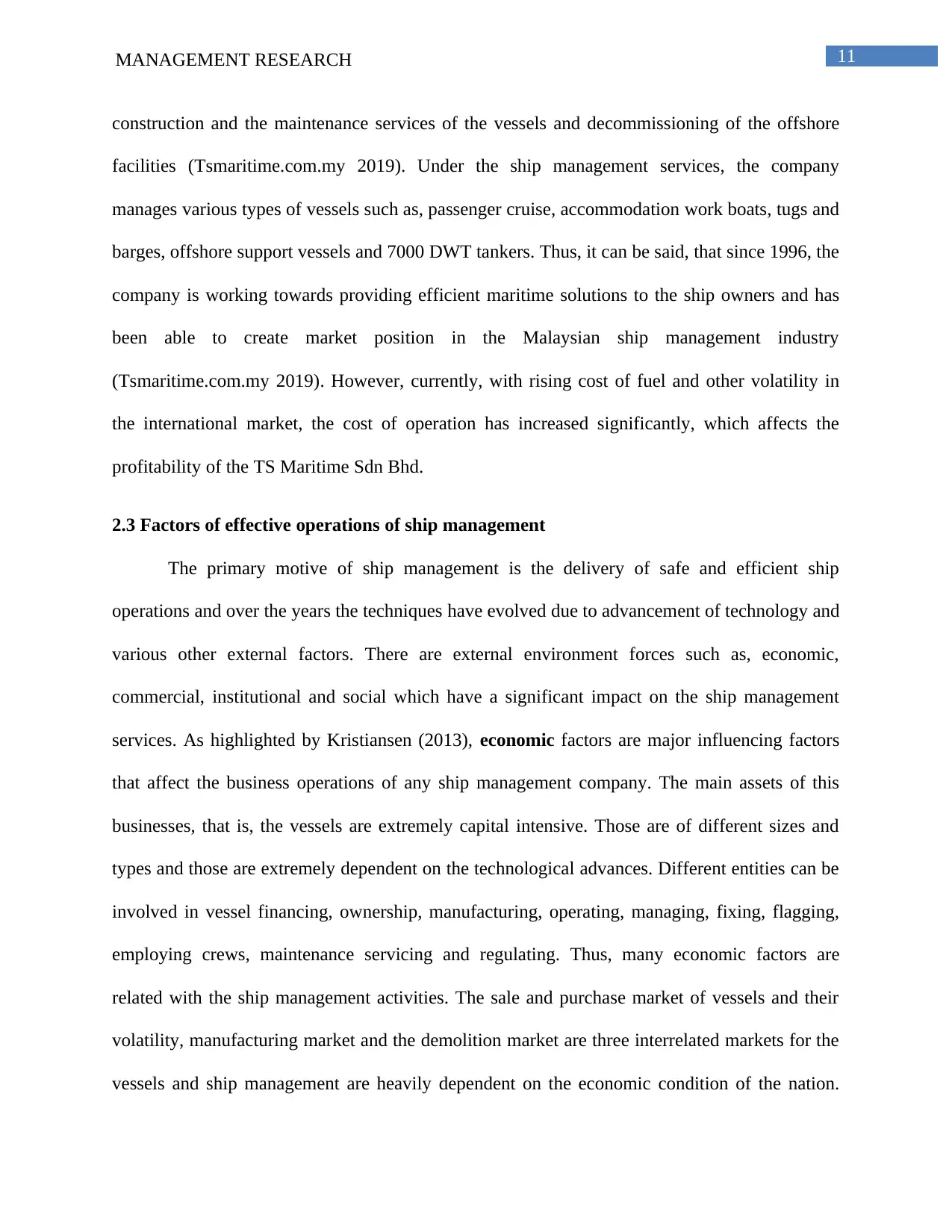
11MANAGEMENT RESEARCH
construction and the maintenance services of the vessels and decommissioning of the offshore
facilities (Tsmaritime.com.my 2019). Under the ship management services, the company
manages various types of vessels such as, passenger cruise, accommodation work boats, tugs and
barges, offshore support vessels and 7000 DWT tankers. Thus, it can be said, that since 1996, the
company is working towards providing efficient maritime solutions to the ship owners and has
been able to create market position in the Malaysian ship management industry
(Tsmaritime.com.my 2019). However, currently, with rising cost of fuel and other volatility in
the international market, the cost of operation has increased significantly, which affects the
profitability of the TS Maritime Sdn Bhd.
2.3 Factors of effective operations of ship management
The primary motive of ship management is the delivery of safe and efficient ship
operations and over the years the techniques have evolved due to advancement of technology and
various other external factors. There are external environment forces such as, economic,
commercial, institutional and social which have a significant impact on the ship management
services. As highlighted by Kristiansen (2013), economic factors are major influencing factors
that affect the business operations of any ship management company. The main assets of this
businesses, that is, the vessels are extremely capital intensive. Those are of different sizes and
types and those are extremely dependent on the technological advances. Different entities can be
involved in vessel financing, ownership, manufacturing, operating, managing, fixing, flagging,
employing crews, maintenance servicing and regulating. Thus, many economic factors are
related with the ship management activities. The sale and purchase market of vessels and their
volatility, manufacturing market and the demolition market are three interrelated markets for the
vessels and ship management are heavily dependent on the economic condition of the nation.
construction and the maintenance services of the vessels and decommissioning of the offshore
facilities (Tsmaritime.com.my 2019). Under the ship management services, the company
manages various types of vessels such as, passenger cruise, accommodation work boats, tugs and
barges, offshore support vessels and 7000 DWT tankers. Thus, it can be said, that since 1996, the
company is working towards providing efficient maritime solutions to the ship owners and has
been able to create market position in the Malaysian ship management industry
(Tsmaritime.com.my 2019). However, currently, with rising cost of fuel and other volatility in
the international market, the cost of operation has increased significantly, which affects the
profitability of the TS Maritime Sdn Bhd.
2.3 Factors of effective operations of ship management
The primary motive of ship management is the delivery of safe and efficient ship
operations and over the years the techniques have evolved due to advancement of technology and
various other external factors. There are external environment forces such as, economic,
commercial, institutional and social which have a significant impact on the ship management
services. As highlighted by Kristiansen (2013), economic factors are major influencing factors
that affect the business operations of any ship management company. The main assets of this
businesses, that is, the vessels are extremely capital intensive. Those are of different sizes and
types and those are extremely dependent on the technological advances. Different entities can be
involved in vessel financing, ownership, manufacturing, operating, managing, fixing, flagging,
employing crews, maintenance servicing and regulating. Thus, many economic factors are
related with the ship management activities. The sale and purchase market of vessels and their
volatility, manufacturing market and the demolition market are three interrelated markets for the
vessels and ship management are heavily dependent on the economic condition of the nation.
⊘ This is a preview!⊘
Do you want full access?
Subscribe today to unlock all pages.

Trusted by 1+ million students worldwide
1 out of 49
Related Documents
Your All-in-One AI-Powered Toolkit for Academic Success.
+13062052269
info@desklib.com
Available 24*7 on WhatsApp / Email
![[object Object]](/_next/static/media/star-bottom.7253800d.svg)
Unlock your academic potential
Copyright © 2020–2025 A2Z Services. All Rights Reserved. Developed and managed by ZUCOL.





